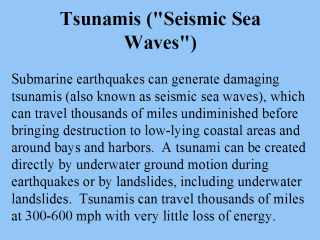 |
Wave heights in deep ocean water
may be only a few feet and pass under ships with little disturbance, but in shallow
coastal waters wave heights can reach 100 feet with devastating impact on local shipping
and shoreline communities. Successive crests may arrive at intervals of every 10-45
minutes and wreak destruction for several hours. The Pacific coast of the United States
is at greatest risk from tsunamis, primarily from earthquakes in South America and the
Alaska/Aleutian Island region. For example, the 1964 Alaska earthquake generated tsunamis
up to 20 feet in height along the coasts of Washington, Oregon, and California and caused
extensive damage in Alaska and Hawaii. The death toll from these tsunamis was 122 compared
with only 9 nearer the epicenter of the earthquake itself. Tsunamis are clearly the
leading earthquake-related threat to the inhabitants of Hawaii. More recently, tsunamis
triggered by earthquakes accounted for the majority of the deaths and serious injuries in
Nicaragua (1992), northern Japan (1993), and Indonesia (1992 and 1994) (54-56). |
